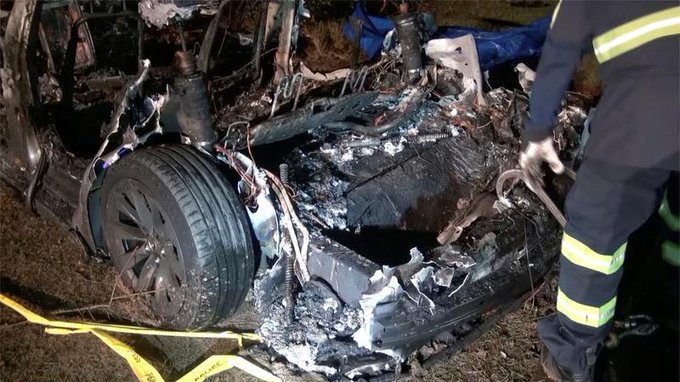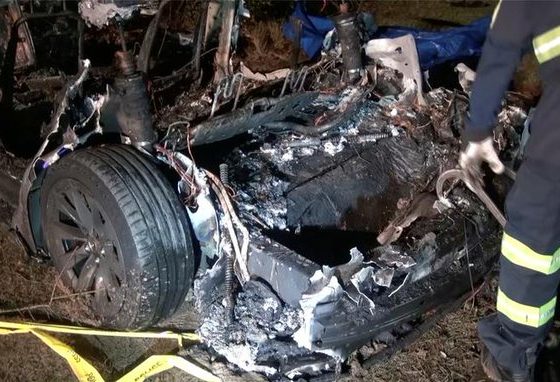

News
New details on fatal Tesla crash in Texas revealed in Fire Marshal report
A report from the Harris County Fire Marshal’s Office has provided several new details about the high-profile, fatal Tesla Model S crash that happened earlier this month in Texas. The incident, which triggered a wave of inaccurate reports suggesting that the ill-fated vehicle was “driverless,” has rekindled conversations about Tesla’s response to misinformation and the dangers of irresponsible driving.
Immediately after the crash, Harris County Pct. 4 Constable Mark Herman remarked that reconstructionists who responded to the accident were “100% certain that no one was in the driver seat driving that vehicle at the time of impact.” This triggered reports alleging that Autopilot was somehow involved. Herman also remarked that the blaze that resulted from the crash took about four hours to be extinguished, and that firefighters had to call for Tesla for tips on how to address the ill-fated Model S’ battery fire.
These statements were promptly corrected by CEO Elon Musk, who noted that data logs indicate that Autopilot was not enabled during the incident. Fire Chief of The Woodlands Township Fire Department Palmer Buck also corrected reports about the Model S’ battery fire, noting that the blaze was controlled within two to three minutes. After this, it was no longer an active fire, as the fire department was just focused on keeping the battery as cool as possible. Buck also noted that fire personnel did not call Tesla for help on how to handle the vehicle fire.
According to the recent report from the Harris County Fire Marshal’s Office, the vehicle had sustained a “significant front-end collision” that may have damaged its battery, power distribution system, or battery-temperature control systems. While investigator Chris Johnson noted that he was unable to determine the first heat source of the blaze, he concluded that the fire was caused by the Model S’ collision with the tree. The report also noted that the fire was well underway by the time authorities were on the scene, destroying most parts of the vehicle.
The report provided some details about the ill-fated Model S’ two passengers, both of whom perished in the incident. According to the report, the vehicle’s interior had extensive fire damage when some authorities arrived, and most of the combustible materials in the space had already been destroyed. The crash’s victims, William Varner, 59, and Everette Talbot, 69, were on seats whose frames were already visible due to extensive fire damage.
“Decedent 1 was located in a seated position, a few inches forward of the front right (passenger) seat. Decedent 1’s upper torso was in a forward-leaning position, with both arms forward… Decedent 2 was located in a seated position within the rear left (passenger) seat. Decedent 2’s upper torso was in a rear-leaning position, with both arms rolled back in a pugilistic pose,” the report read.
As noted by Tesla in its Q1 earnings call, the company is currently working directly with local authorities, the NTSB, and the NHTSA, to investigate the incident. Tesla Vice President of Vehicle Engineering Lars Moravy added that so far, an inspection of the ill-fated vehicle revealed that the steering wheel was deformed. This, together with the fact that Autopilot was not activated and that all seatbelts post-crash were unbuckled, hints at the likelihood that someone was in the driver’s seat at the time of the crash.
The report from the Harris County Fire Marshal’s Office could be accessed below.
Tesla TX Crash Fire Marshal Incident Report by Simon Alvarez on Scribd
Don’t hesitate to contact us for news tips. Just send a message to tips@teslarati.com to give us a heads up.

Elon Musk
Elon Musk and Tesla AI Director share insights after empty driver seat Robotaxi rides
The executives’ unoccupied tests hint at the rapid progress of Tesla’s unsupervised Robotaxi efforts.

Tesla CEO Elon Musk and AI Director Ashok Elluswamy celebrated Christmas Eve by sharing personal experiences with Robotaxi vehicles that had no safety monitor or occupant in the driver’s seat. Musk described the system’s “perfect driving” around Austin, while Elluswamy posted video from the back seat, calling it “an amazing experience.”
The executives’ unoccupied tests hint at the rapid progress of Tesla’s unsupervised Robotaxi efforts.
Elon and Ashok’s firsthand Robotaxi insights
Prior to Musk and the Tesla AI Director’s posts, sightings of unmanned Teslas navigating public roads were widely shared on social media. One such vehicle was spotted in Austin, Texas, which Elon Musk acknowleged by stating that “Testing is underway with no occupants in the car.”
Based on his Christmas Eve post, Musk seemed to have tested an unmanned Tesla himself. “A Tesla with no safety monitor in the car and me sitting in the passenger seat took me all around Austin on Sunday with perfect driving,” Musk wrote in his post.
Elluswamy responded with a 2-minute video showing himself in the rear of an unmanned Tesla. The video featured the vehicle’s empty front seats, as well as its smooth handling through real-world traffic. He captioned his video with the words, “It’s an amazing experience!”
Towards Unsupervised operations
During an xAI Hackathon earlier this month, Elon Musk mentioned that Tesla owed be removing Safety Monitors from its Robotaxis in Austin in just three weeks. “Unsupervised is pretty much solved at this point. So there will be Tesla Robotaxis operating in Austin with no one in them. Not even anyone in the passenger seat in about three weeks,” he said. Musk echoed similar estimates at the 2025 Annual Shareholder Meeting and the Q3 2025 earnings call.
Considering the insights that were posted Musk and Elluswamy, it does appear that Tesla is working hard towards operating its Robotaxis with no safety monitors. This is quite impressive considering that the service was launched just earlier this year.
Elon Musk
Starlink passes 9 million active customers just weeks after hitting 8 million
The milestone highlights the accelerating growth of Starlink, which has now been adding over 20,000 new users per day.

SpaceX’s Starlink satellite internet service has continued its rapid global expansion, surpassing 9 million active customers just weeks after crossing the 8 million mark.
The milestone highlights the accelerating growth of Starlink, which has now been adding over 20,000 new users per day.
9 million customers
In a post on X, SpaceX stated that Starlink now serves over 9 million active users across 155 countries, territories, and markets. The company reached 8 million customers in early November, meaning it added roughly 1 million subscribers in under seven weeks, or about 21,275 new users on average per day.
“Starlink is connecting more than 9M active customers with high-speed internet across 155 countries, territories, and many other markets,” Starlink wrote in a post on its official X account. SpaceX President Gwynne Shotwell also celebrated the milestone on X. “A huge thank you to all of our customers and congrats to the Starlink team for such an incredible product,” she wrote.
That growth rate reflects both rising demand for broadband in underserved regions and Starlink’s expanding satellite constellation, which now includes more than 9,000 low-Earth-orbit satellites designed to deliver high-speed, low-latency internet worldwide.
Starlink’s momentum
Starlink’s momentum has been building up. SpaceX reported 4.6 million Starlink customers in December 2024, followed by 7 million by August 2025, and 8 million customers in November. Independent data also suggests Starlink usage is rising sharply, with Cloudflare reporting that global web traffic from Starlink users more than doubled in 2025, as noted in an Insider report.
Starlink’s momentum is increasingly tied to SpaceX’s broader financial outlook. Elon Musk has said the satellite network is “by far” the company’s largest revenue driver, and reports suggest SpaceX may be positioning itself for an initial public offering as soon as next year, with valuations estimated as high as $1.5 trillion. Musk has also suggested in the past that Starlink could have its own IPO in the future.
News
NVIDIA Director of Robotics: Tesla FSD v14 is the first AI to pass the “Physical Turing Test”
After testing FSD v14, Fan stated that his experience with FSD felt magical at first, but it soon started to feel like a routine.

NVIDIA Director of Robotics Jim Fan has praised Tesla’s Full Self-Driving (Supervised) v14 as the first AI to pass what he described as a “Physical Turing Test.”
After testing FSD v14, Fan stated that his experience with FSD felt magical at first, but it soon started to feel like a routine. And just like smartphones today, removing it now would “actively hurt.”
Jim Fan’s hands-on FSD v14 impressions
Fan, a leading researcher in embodied AI who is currently solving Physical AI at NVIDIA and spearheading the company’s Project GR00T initiative, noted that he actually was late to the Tesla game. He was, however, one of the first to try out FSD v14.
“I was very late to own a Tesla but among the earliest to try out FSD v14. It’s perhaps the first time I experience an AI that passes the Physical Turing Test: after a long day at work, you press a button, lay back, and couldn’t tell if a neural net or a human drove you home,” Fan wrote in a post on X.
Fan added: “Despite knowing exactly how robot learning works, I still find it magical watching the steering wheel turn by itself. First it feels surreal, next it becomes routine. Then, like the smartphone, taking it away actively hurts. This is how humanity gets rewired and glued to god-like technologies.”
The Physical Turing Test
The original Turing Test was conceived by Alan Turing in 1950, and it was aimed at determining if a machine could exhibit behavior that is equivalent to or indistinguishable from a human. By focusing on text-based conversations, the original Turing Test set a high bar for natural language processing and machine learning.
This test has been passed by today’s large language models. However, the capability to converse in a humanlike manner is a completely different challenge from performing real-world problem-solving or physical interactions. Thus, Fan introduced the Physical Turing Test, which challenges AI systems to demonstrate intelligence through physical actions.
Based on Fan’s comments, Tesla has demonstrated these intelligent physical actions with FSD v14. Elon Musk agreed with the NVIDIA executive, stating in a post on X that with FSD v14, “you can sense the sentience maturing.” Musk also praised Tesla AI, calling it the best “real-world AI” today.








